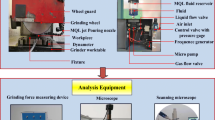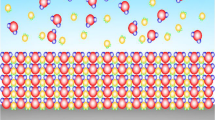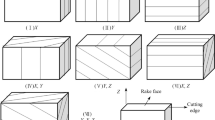Abstract
The special mechanical properties of cemented carbide with high strength and hardness will cause complex stress due to excessive force and heat in the process of precision manufacturing, which will affect precision retention and endurance limit. Given the health and environmental threat of conventional flood cooling and the harsh processing environment of dry grinding, minimum quantity lubrication (MQL) has become an irreplaceable method to machining cemented carbide. However, the addition of nanoparticles changes the force and heat during grinding, which makes the influence on the residual stress of cemented carbide complicated. Therefore, based on the single abrasive grinding force model, the effective abrasive particle number was obtained by simulating the distribution of abrasive particles on the grinding wheel surface, and the mechanical stress model was established, which was loaded onto the workpiece in iterative attenuation mode. The thermal stress model was established based on the temperature field model. The final residual stress prediction model was obtained by determining whether the grinding process yields results and carrying out stress loading and stress relaxation. Experimental verification of the model was carried out under four different grinding conditions of YG8. The minimum friction coefficient of 0.385 was obtained under nanofluid minimum quantity lubrication (NMQL). In the precision analysis of the model, the minimum error value was 5.9% in the direction perpendicular to the feed direction of the workpiece in the dry grinding condition, which proved that the residual stress model had certain reliability.















Similar content being viewed by others
Availability of data and material
Data sharing is not applicable to this article.
Code availability
Code availability is not applicable to this article.
References
Mao C, Liang C, Zhang YC, Zhang MJ, Hu YL, Bi ZM (2017) Grinding characteristics of cBN-WC-10Co composites. Ceram Int 43(18):16539–16547. https://doi.org/10.1016/j.ceramint.2017.09.040
Mao C, Lu J, Zhao ZH, Yin LR, Hu YL, Bi ZM (2018) Simulation and experiment of cutting characteristics for single cBN-WC-10Co fiber. Precis Eng 52:170–182. https://doi.org/10.1016/j.precisioneng.2017.12.001
Yang J, Odén M, Johansson-Jesaar MP, Lianes L (2014) Grinding effects on surface integrity and mechanical strength of WC-Co cemented carbides. Procedia CIRP 13(1):257–263. https://doi.org/10.1016/j.procir.2014.04.044
Skordaris G, Charalampous P, Kotsanis T, Bouzakis E, Lemmer KD (2016) Effect of structure and residual stresses of diamond coated cemented carbide tools on the film adhesion and developed wear mechanisms in milling. CIRP Ann. https://doi.org/10.1016/j.cirp.2016.1004.1007
Thomisch M, Kalhoefer E, Kley M, Schmid H, Savsek O (2017) Residual stress on surfaces caused by mechanical grinding on high strength spring steel. Materialwiss Werkst 48(6):495–501. https://doi.org/10.1002/mawe.201700021
Zhang YX, Yang X, Yuan SS, Zhu JH, Wang D (2021) Residual stress of high speed cylindrical grinding of 18CrNiMo7-6 steel. China Mechanical Engineering 32(5):540–546
Wang RX, Zhou K, Yang JY, Ding H, Liu Q (2020) Effects of abrasive material and hardness of grinding wheel on rail grinding behaviors. Wear 454–455:203332. https://doi.org/10.1016/j.wear.2020.203332
Neslušan M, Mrkvica I, Čep R, Raos P (2012) Heat distribution when nickel alloy grinding. Teh Vjesn 19(4):947–951
Azarhoushang B, Daneshi A, Lee D (2017) Evaluation of thermal damages and residual stresses in dry grinding by structured wheels. J Clean Prod 142:1922–1930. https://doi.org/10.1016/j.jclepro.2016.11.091
Shao YM, Fergani O, Ding ZS, Li BZ, Liang SY (2016) Experimental investigation of residual stress in minimum quantity lubrication grinding of AISI 1018 steel. J Manuf Sci Eng 138(1). https://doi.org/10.1115/1111.4029956
Lee PH, Nam JS, Li C, Sang WL (2012) An experimental study on micro-grinding process with nanofluid minimum quantity lubrication (MQL). Int J Precis Eng Man 13(3):331–338. https://doi.org/10.1007/s12541-012-0042-2
Paul S, Ghosh A (2019) Grinding of WC-Co cermets using hexagonal boron nitride nano-aerosol. Int J Refract Met H 78:264–272. https://doi.org/10.1016/j.ijrmhm.2018.10.005
Manoj KK, Ghosh A (2021) On grinding force ratio, specific energy, G-ratio and residual stress in SQCL assisted grinding using aerosol of MWCNT nanofluid. Mach Sci Technol 25(4):585–607. https://doi.org/10.1080/10910344.2021.1903920
Li J, Jia YK, Shen NY, Yu Z, Zhang W (2015) Effect of grinding conditions of a TC4 titanium alloy on its residual surface stresses. Strength Mater 47(1):2–11. https://doi.org/10.1007/s11223-015-9621-7
Shah SM, Nélias D, Zain-Ul-Abdein M, Coret M (2012) Numerical simulation of grinding induced phase transformation and residual stresses in AISI-52100 steel. Finite Elem Anal Des 61:1–11. https://doi.org/10.1016/j.finel.2012.1005.1010
Rajaei A, Hallstedt B, Broeckmann C, Barth S, Trauth D, Bergs T (2018) Numerical prediction of the microstructure and stress evolution during surface grinding of AISI 52100 (DIN 100Cr6). Integr Mater Manuf Innov 7(4):202–213. https://doi.org/10.1007/s40192-018-0122-y
Xu YQ, Zhang T, Bai YM (2011) Analysis of the surface residual stress in grinding Aermet100. Mater Sci Forum 704–705:318–324. https://doi.org/10.4028/www.scientific.net/MSF.704-705.318
Wang Y, Zhang W, Liu Y (2018) Analysis model for surface residual stress distribution of spiral bevel gear by generating grinding. Mech Mach Theory 130:477–490. https://doi.org/10.1016/j.mechmachtheory.2018.08.027
Sun C, Xiu S, Hong Y, Kong X, Lu Y (2020) Prediction on residual stress with mechanical-thermal and transformation coupled in DGH. Int J Mech Sci 179. https://doi.org/10.1016/j.ijmecsci.2020.105629
Shao YM, Fergani O, Li BZ, Liang SY (2016) Residual stress modeling in minimum quantity lubrication grinding. Int J Adv Manuf Tech 83(5–8):743–751. https://doi.org/10.1007/s00170-015-7527-y
Thampi AD, Prasanth MA, Anandu AP, Sneha E, Sasidharan B, Rani S (2021) The effect of nanoparticle additives on the tribological properties of various lubricating oils–Review. Mater Today: Proc 47(15):4919–4924. https://doi.org/10.1016/j.matpr.2021.03.664
Mujtaba MA, Kalam MA, Masjuki HH, Soudagar MEM, Khan HM, Fayaz H, Farooq M, Gul M, Ahmed W, Ahmad M (2021) Effect of palm-sesame biodiesel fuels with alcoholic and nanoparticle additives on tribological characteristics of lubricating oil by four ball tribo-tester. Alex Eng J 60(5):4537–4546. https://doi.org/10.1016/j.aej.2021.03.017
Xiong S, Zhang B, Luo S, Wu H, Zhang Z (2021) Preparation, characterization, and tribological properties of silica-nanoparticle-reinforced BN-co-doped reduced graphene oxide as a multifunctional additive for enhanced lubrication. Friction 9(2):239–249. https://doi.org/10.1007/s1-0331-019-40544
Ren BJ, Gao L, Li MJ, Zhang SD, Ran X (2020) Tribological properties and anti-wear mechanism of ZnO@ graphene core-shell nanoparticles as lubricant additives. Tribol Int 144:106114. https://doi.org/10.1016/j.triboint.2019.106114
Gao T, Li CH, Yang M, Zhang YB, Wang J (2021) Mechanics analysis and predictive force models for the single-diamond grain grinding of carbon fiber reinforced polymers using CNT nano-lubricant. J Mater Process Tech 290(9–12):116976. https://doi.org/10.1016/j.jmatprotec.2020.116976
Sui MH, Zhang NQ, Li CH, Wu WT, Zhang YB, Yang M (2020) Theroetical analysis and experiment on temperature field of nano-fluid micro-lubrication grinding cemented carbide. Manufacturing Technology & Machine Tool 693(03):81–87
Ji X, Zhang X, Liang SY (2014) Predictive modeling of residual stress in minimum quantity lubrication machining. Int J Adv Manuf Tech 70(9–12):2159–2168. https://doi.org/10.1007/s00170-013-5439-2
Li BM, Zhao B (2003) Modern grinding technology. China machine press, Published
Zhang Y, Li C, Yang M, Jia D, Li J (2018) Analysis of single-grain interference mechanics based on material removal and plastic stacking mechanisms in nanofluid minimum quantity lubrication grinding. Procedia CIRP 71:116–121. https://doi.org/10.1016/j.procir.2018.05.082
Li CH, Zhang XW, Zhang Q, Wang S, Zhang DK, Jia DZ, Zhang YB (2014) Modeling and simulation of useful fluid flow rate in grinding. Int J Adv Manuf Tech 75(9–12):1587–1604. https://doi.org/10.1007/s00170-014-6257-x
Hou ZB, Komanduri R (2003) On the mechanics of the grinding process – Part I. Stochastic nature of the grinding process. Int J Mach Tool Manu 43(15):1579–1593. https://doi.org/10.1016/S0890-6955(03)00186-X
Conway HD (1953) The stress distributions induced by concentrated loads acting in isotropic and orthotropic half planes. J Appl Mech 20(1):82–86. https://doi.org/10.1093/qjmam/1097.1094.1505
Saif M, Hui CY, Zehnder AT (1993) Interface shear stresses induced by non-uniform heating of a film on a substrate. Thin Solid Films 224(2):159–167
Mcdowell DL (1997) An approximate algorithm for elastic-plastic two-dimensional rolling/sliding contact. Wear 211(2):237–246. https://doi.org/10.1016/S0043-1648(97)00117-8
Nguyen T, Zhang LC, Sun DL, Wu Q (2014) Characterizing the mechanical properties of the hardened layer induced by grinding-hardening. Mach Sci Technol 18(2):277–298. https://doi.org/10.1080/10910344.2014.897845
Choudhary A, Paul S (2021) Surface generation in high-speed grinding of brittle and tough ceramics. Ceram Int 47(21):30546–30562. https://doi.org/10.1016/j.ceramint.2021.07.233
Zhao B, Ding W, Xiao G, Zhao J, Li Z (2021) Effects of open pores on grinding performance of porous metal-bonded aggregated cBN wheels during grinding Ti–6Al–4V alloys. Ceram Int 47(22):31311–31318. https://doi.org/10.1016/j.ceramint.2021.08.004
Mao C, Liang C, Zhang Y, Zhang M, Hu Y, Bi Z (2017) Grinding characteristics of cBN-WC-10Co composites. Ceram Int 43(18):16539–16547. https://doi.org/10.1016/j.ceramint.2017.09.040
Yang J, Roa JJ, Schwind M, Odén M, Johansson-Jõesaar MP, Llanes L (2017) Grinding-induced metallurgical alterations in the binder phase of WC-Co cemented carbides. Mater Charact 134:302–310. https://doi.org/10.1016/j.matchar.2017.11.004
Wirtz C, Mueller S, Mattfeld P, Klocke F (2017) A discussion on material removal mechanisms in grinding of cemented carbides. J Manuf Sci E-T ASME 139(12). https://doi.org/10.1115/1.4036995
Yang M, Li CH, Luo L, Li R, Long Y (2021) Predictive model of convective heat transfer coefficient in bone micro-grinding using nanofluid aerosol cooling. Int Commun Heat Mass 125:105317. https://doi.org/10.1016/j.icheatmasstransfer.2021.105317
Yang M, Li CH, Said Z, Zhang Y, Li R, Debnath S, Ali HM, Gao T, Long Y (2021) Semiempirical heat flux model of hard-brittle bone material in ductile microgrinding. J Manuf Process 71:501–514. https://doi.org/10.1016/j.jmapro.2021.09.053
Zhang YB, Li CH, Yang M, Jia DZ, Wang Y, Li B, Hou Y, Zhang N, Wu Q (2016) Experimental evaluation of cooling performance by friction coefficient and specific friction energy in nanofluid minimum quantity lubrication grinding with different types of vegetable oil. J Clean Prod 139(15):685–705. https://doi.org/10.1016/j.jclepro.2016.08.073
Stachurski W, Sawicki J, Krupanek K, Nadolny K (2020) Application of numerical simulation to determine ability of air used in MQL method to clean grinding wheel active surface during sharpening of hob cutters. Int J PR Eng MAN-GT 8(3):1095–1112. https://doi.org/10.1007/s40684-020-00239-x
Denkena B, Grove T, Lucas H (2016) Influences of grinding with Toric CBN grinding tools on surface and subsurface of 1.3344PM steel. J Mater Process Tech 229:541–548. https://doi.org/10.1016/j.jmatprotec.2015.09.039
Hosseini SF, Emami M, Sadeghi MH (2018) An experimental investigation on the effects of minimum quantity nano lubricant application in grinding process of Tungsten carbide. J Manuf Process 35:244–253. https://doi.org/10.1016/j.jmapro.2018.08.007
Shi Z, Guo S, Liu H, Li C, Zhang Y, Yang M, Chen Y, Liu B, Zhou Z, Nie X (2021) Experimental evaluation of minimum quantity lubrication of biological lubricant on grinding properties of GH4169 nickel-base alloy. Surface Technology 1–17
Yin Q, Li C, Dong L, Bai X, Liu Z (2021) Effects of physicochemical properties of different base oils on friction coefficient and surface roughness in MQL milling AISI 1045. Int J PR Eng MAN-GT 8(1):1629–1647. https://doi.org/10.1007/s00170-021-08076-1
Zhang YB, Li CH, Jia DZ, Li B, Wang YG, Yang M, Hou YL, Zhang X (2016) Experimental study on the effect of nanoparticle concentration on the lubricating property of nanofluids for MQL grinding of Ni-based alloy. J Mater Process Tech 100–115. https://doi.org/10.1016/j.jmatprotec.2016.01.031
Wang Y, Li C, Zhang Y, Yang M, Li B (2018) Processing characteristics of vegetable oil-based nanofluid MQL for grinding different workpiece materials. Int J PR Eng MAN-GT 5:327–339. https://doi.org/10.1007/s40684-018-0035-4
Zhang J, Wu W, Li C, Yang M, Ali HM (2020) Convective heat transfer coefficient model under nanofluid minimum quantity lubrication coupled with cryogenic air grinding Ti–6Al–4V. Int J PR Eng MAN-GT 7–8:1–23. https://doi.org/10.1007/s40684-020-00268-6
Miao Q, Ding WF, Kuang WJ, Yang CY (2021) Grinding force and surface quality in creep feed profile grinding of turbine blade root of nickel-based superalloy with microcrystalline alumina abrasive wheels. Chinese J Aeronaut
Gao T, Li C, Jia D, Zhang Y, Xu X (2020) Surface morphology assessment of CFRP transverse grinding using CNT nanofluid minimum quantity lubrication. J Clean Prod 123328. https://doi.org/10.1016/j.jclepro.2020.123328
Zhao Z, Qian N, Ding W, Wang Y, Fu Y (2020) Profile grinding of DZ125 nickel-based superalloy: Grinding heat, temperature field, and surface quality. J Manuf Process 57:10–22. https://doi.org/10.1016/j.jmapro.2020.1006.1022
Duc TM, Long TT, Chien TQ (2019) Performance evaluation of MQL parameters using Al2O3 and MoS2 nanofluids in hard turning 90CrSi steel. Lubricants 7(40):1–17. https://doi.org/10.3390/lubricants7050040
Wu C, Yang K, Chen Y, Ni J, Yao LD, Li XL (2021) Investigation of friction and vibration performance of lithium complex grease containing nano-particles on rolling bearing. Tribol Int 155:106761. https://doi.org/10.1016/j.triboint.2020.106761
Funding
This study was financially supported by the National Natural Science Foundation of China (Grant Nos. 51975305 and 51905289), the Major Research Project of Shandong Province (Grant Nos. 2019GGX104040 and 2019GSF108236), the Major Science and Technology Innovation Engineering Projects of Shandong Province (Grant No. 2019JZZY020111), the Natural Science Foundation of Shandong Province (Grant No. ZR2020KE027) and the National Key Research and Development Plan (Grant No.2020YFB2010500).
Author information
Authors and Affiliations
Contributions
Zechen Zhang: investigation, writing (original draft), and writing (review and editing); Menghua Sui: collect and organize data; Changhe Li: technical and material support; instructional support, and writing (review); Zongming Zhou: formal analysis, validation; Bo Liu: formal analysis, validation; Yun Chen: modify paper, validation; Zafar Said: statistical analysis, validation; Sujan Debnath: conceptualization, validation; Shubham Sharma: formal analysis, validation.
Corresponding author
Ethics declarations
Ethics approval
We declare that the papers we submitted are our research work under the guidance of the instructor and research results we have obtained. We confirm that this article has not been published previously and is not being submitted for publication elsewhere. We have not considered elsewhere except The International Journal of Advanced Manufacturing Technology. We confirm that this article has the full consent of all authors. If this article was accepted, we confirm that it will not be published elsewhere in the same form, in English or in any other language, without the written consent of the publisher.
Consent to participate
Consent to participate is not applicable to this article.
Consent for publication
The authors declare that they participated in this paper willingly and the authors declare to consent to the publication of this paper.
Conflicts of interest/Competing interests
The authors have no financial or proprietary interests in any material discussed in this article.
Additional information
Publisher's Note
Springer Nature remains neutral with regard to jurisdictional claims in published maps and institutional affiliations.
Rights and permissions
About this article
Cite this article
Zhang, Z., Sui, M., Li, C. et al. Residual stress of grinding cemented carbide using MoS2 nano-lubricant. Int J Adv Manuf Technol 119, 5671–5685 (2022). https://doi.org/10.1007/s00170-022-08660-z
Received:
Accepted:
Published:
Issue Date:
DOI: https://doi.org/10.1007/s00170-022-08660-z




